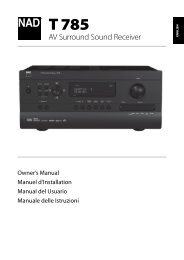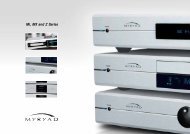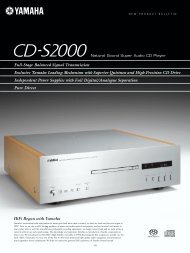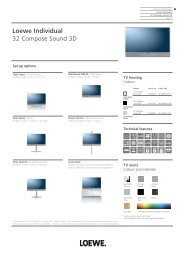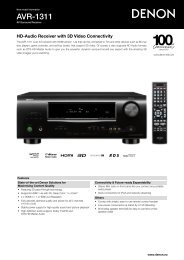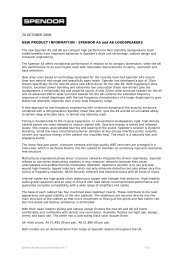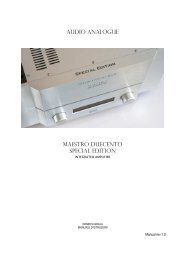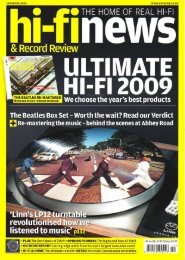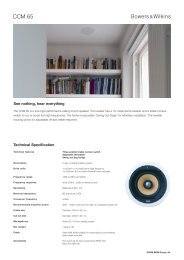Create successful ePaper yourself
Turn your PDF publications into a flip-book with our unique Google optimized e-Paper software.
Innovative Technologies<br />
Pure Digital Path Direct from Source<br />
TEAC’s all new CR-H500DNT and AG-H380DAB set new<br />
standards in stylish digital audio. USB ports allow iPod<br />
connection via the USB cable supplied with your iPod,<br />
directly from the 30-pin digital audio connector on the<br />
iPod to a hi-fidelity standard D/A converter on both the<br />
CR-H500DNT and the AG-H380DAB. This creates perfect<br />
processing from the digital file to the amplifier section,<br />
through a USB cable carrying a pure digital format signal,<br />
without losing any audio data in the process. The flawless<br />
digital audio data is processed in a D/A converter and<br />
then delivered to the amplifier section.<br />
This gives improved digital-to-analogue conversion<br />
compared to just processing the signal through the iPod<br />
- and using a better D/A converter always reveals a more<br />
authentic and defined way of imaging the finer detail of<br />
audio waveforms.<br />
In addition, digital audio data reproduced from a silicon<br />
memory – such as with iPod touch and nano, which<br />
employ silicon memory for music storage, and iPod classic<br />
and iPod video, which employ a matchbox size HDD – is<br />
free from jitter noise, which is an unfortunate by-product<br />
of an HDD motor, or CD mechanism, even on high-end<br />
CD players.<br />
To get the best performance in audio processing when<br />
using TEAC hi-fi products always select a linear audio<br />
format like ”AIFF” or ”WAV” from the preference menu<br />
of iTunes when ripping a CD. This way 100% of the CD’s<br />
original data is stored on your iPod.<br />
In the past, audiophiles would upgrade their phono<br />
cartridge to improve sound, because it was at the very<br />
heart of the audio performance from vinyl disc contact to<br />
the electrical signal. Now, choosing a more advanced D/A<br />
converter is the modern route to audio quality perfection.<br />
What is Internet-Radio?<br />
Internet-Radio, also known as streaming radio or webradio,<br />
is an audio broadcasting service on the internet.<br />
Most of the broadcasters on the internet are existing<br />
broadcasting stations for FM or AM, and they are<br />
transmitting the same programme to the internet<br />
simultaneously. However, there are thousands of internetexclusive<br />
broadcasters and personal-based stations<br />
out there. Moreover, the number of stations has been<br />
increasing day by day and the total number has reached<br />
over 12,000.<br />
The most interesting characteristic of Internet-Radio is that<br />
it is ”Borderless” which no other traditional broadcasting<br />
medium is. It is also accessible from anywhere in the<br />
world, whenever you connect to the internet, via either<br />
wire or wireless.<br />
Once you connect to the internet, the Internet-Radio<br />
tuner displays a dozen of the thousands of station<br />
names by genre, or by country, and narrowing the list<br />
by selecting a sub-genre, and clicking on clicks a station<br />
name gets you want to try. Digital audio signal from<br />
the station travels over the internet, across the city limit,<br />
borders, mountains, or even the Atlantic Ocean, with the<br />
speed of light.<br />
Internet-Radio turns you into an armchair music world<br />
traveller. Furthermore, Internet-Radio is not just for music<br />
lovers. Almost all interests, religious, news, comedy or<br />
talk stations programmes can be heard in your preferred<br />
language. Internet-Radio will make a significant difference<br />
to your listening choice and habits forever.<br />
TEAC <strong>Reference</strong> <strong>Series</strong> <strong>2010</strong><br />
7



